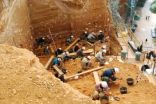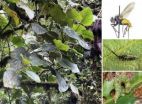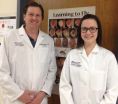(Press-News.org) One of the issues of the Atapuerca sites that generates the most scientific debate is the dating of the strata where the fossils are found. Therefore, researchers at the Spanish National Research Centre for Human Evolution, among others, strive to settle the dates. A study published by the 'Journal of Archaeological Science' has clarified that the sediment of Gran Dolina, where the first remains of Homo antecessor were discovered in 1994, is 900,000 years old.
The findings at the Lower Palaeolithic cave site of Gran Dolina, in the Sierra de Atapuerca mountain range (Burgos), have led to major advancements in our knowledge of human evolution and occupation of Eurasia.
In 1995, specifically, the discovery of the first hominid remains in a stratum of land named TD6, which dated from more than 780,000 years back, was made public in the journal 'Nature'. This was the Homo antecessor, the oldest known hominid species in Europe.
As the dating of this and other archaeological sites is the subject of scientific debate – in 2012, a British newspaper questioned Juan Luis Arsuaga, co-director of the sites, and accused him of "distorting our picture of human evolution" -, the researchers are working to date them more precisely.
As Josep M. Parés, from the Spanish National Research Centre for Human Evolution, who is leading this study on the new dating of level TD6 of the Gran Dolina, tells SINC: "We are applying new methods and techniques, and we also have better field and laboratory knowledge. We have published a study that represents a small step towards a large project which will take us longer: reviewing all the dates in order to refine them. We want to include it all within a more solid geochronological framework."
What this study strictly contributes is the combination of the technique of palaeomagnetism – which entails revising the polarity of the materials constituting stratigraphic layers – with assessing existing dating figures.
"On the one hand we employ paramagnetic resonance, and on the other what is known as optically stimulated luminescence. This provides numerical dates, absolute ages. We have reviewed these and combined them with the new figures from palaeomagnetism in order to expand upon the chronology of this level TD6 of the Gran Dolina and the fossils it contains."
They were previously given a minimum age of 780,000 years and now it is known that they are referring more accurately to around 900,000 years. "The change might sound very small or very large," the expert continues, "but the TD6 stratum is known precisely as having been the place of discovery of the Homo antecessor and this further defines its age."
Since then, a further 90 human fossils and over 200 fragments of carved stone have also been discovered. The extent of the excavation grows ever larger and being able to date it is of great interest to the scientists.
"The site has produced thousands of fossils and artifacts and has become a Pleistocene landmark in studies on early human settlement outside the African continent," the article explains.
Now, they are going to attempt to use individual fossils, especially teeth, and obtain direct dates for the remains found, as well as those already known by their sediments.
"When we handle these figures there are always error margins. For example, when we publish the dating figures for the Sima del Elefante, we are talking about 1.2 million years and the error margin is around 130,000 years. It seems like a huge amount, but it is actually only a small percentage, which can reach 10% of the chronology," Parés concludes.
INFORMATION:
References:
Referencia bibliográfica:
J.M. Parés, L. Arnold, M. Duval, M. Demuro, A. Pérez-González, J.M. Bermúdez de Castro, E. Carbonell, J.L. Arsuaga. "Reassessing the age of Atapuerca-TD6 (Spain): new paleomagnetic results" Journal of Archaeological Science 40: 4586 - 4595, 2013.
Dating is refined for the Atapuerca site where Homo antecessor appeared
2014-02-07
ELSE PRESS RELEASES FROM THIS DATE:
Protein structure: Peering into the transit pore
2014-02-07
The lipid-rich membranes of cells are largely impermeable to proteins, but evolution has provided a way through – in the form of transmembrane tunnels. A new study shows in unmatched detail what happens as proteins pass through such a pore.
Every cell is surrounded by a surface membrane and contains internal compartments bounded by membranes. Almost one-third of all proteins synthesized in cells must pass through these membranes or be incorporated into them in order to fulfil their functions. However, the fat-rich nature of membranes makes it impossible for most proteins ...
Beta blockers and perioperative care: EHJ editorial addresses controversy
2014-02-07
Zurich, 7 February 2014. Since the end of 2011 when the scientific work of Professor Don Poldermans was first scrutinized there has been controversy in the medical world about the use of beta blockers in perioperative care.
The recent publication - and retraction for proper peer reviewing and revision - in the European Heart Journal (EHJ) of a paper by Professors Cole and Francis from Imperial College, questioning whether beta blockers in perioperative care could lead to a mortality increase brought the topic back into the public eye.
The EHJ has published an editorial ...
The biomass of ocean mesopelagic fish is 10 times higher than estimated
2014-02-07
The total stock of fish on the planet had been reckoned until today to be around 2,000 million tonnes. About half of them were thought to be mesopelagic fish, in other words, ones found at depths of between 200 and 1,000 metres in ocean areas.
However, an international team*, in which AZTI-Tecnalia researchers are participating and which is being led by the doctor in oceanography Xabier Irigoien, has discovered that its abundance could be at least 10 times higher than the original estimate. The results have been published in the journal Nature Communications.
Mesopelagic ...
New plant species a microcosm of biodiversity
2014-02-07
Biologists working in the Andes mountains of Ecuador have described a new plant species, a wild relative of black pepper, that is in itself a mini biodiversity hotspot. The new species, Piper kelleyi, is the sole home of an estimated 40-50 insect species, most of which are entirely dependent on this plant species for survival. This discovery is part of a larger project which focuses on the influence of plant-produced chemical compounds on biodiversity. The study was published in the open access journal PhytoKeys.
The chemical compounds produced by plants are source of ...
Avian flu variant stalks Egypt
2014-02-07
Since its first identification in Asia, highly pathogenic avian influenza—H5N1—has caused significant alarm in the scientific community. While the virus' primary target is birds—tens of millions have already died from it—it is capable of infecting mammals, including humans, causing serious illness and a frightening rate of mortality.
In a new study, Matthew Scotch, a researcher at Arizona State University's Biodesign Institute, tracks the spread of an H5N1 variant in Egypt—a country recently identified as a major epicenter for the virus. In results recently appearing ...
Substance in photosynthesis was at work in ancient, methane-producing microbes
2014-02-07
An international team of researchers led by scientists at Virginia Tech and the University of California, Berkeley has discovered that a process that turns on photosynthesis in plants likely developed on Earth in ancient microbes 2.5 billion years ago, long before oxygen became available.
The research offers new perspective on evolutionary biology, microbiology, and the production of natural gas, and may shed light on climate change, agriculture, and human health.
"By looking at this one mechanism that was not previously studied, we will be able to develop new basic ...
Finding could explain age-related decline in motor function
2014-02-07
SAN ANTONIO (Feb. 6, 2014) — Scientists from the School of Medicine at The University of Texas Health Science Center at San Antonio have found a clue as to why muscles weaken with age. In a study published Feb. 5 in The Journal of Neuroscience, they report the first evidence that "set points" in the nervous system are not inalterably determined during development but instead can be reset with age. They observed a change in set point that resulted in significantly diminished motor function in aging fruit flies.
"The body has a set point for temperature (98.6 degrees), ...
Gender influences symptoms of genetic disorder
2014-02-07
A genetic disorder that affects about 1 in every 2,500 births can cause a bewildering array of clinical problems, including brain tumors, impaired vision, learning disabilities, behavioral problems, heart defects and bone deformities. The symptoms and their severity vary among patients affected by this condition, known as neurofibromatosis type 1 (NF1).
Now, researchers at Washington University School of Medicine in St. Louis have identified a patient's gender as a clear and simple guidepost to help health-care providers anticipate some of the effects of NF1. The scientists ...
The fatality rate among hard drug users is 14 times higher than for the general population
2014-02-07
A new study analyses the risk factors and excess mortality among heroin and cocaine consumers admitted to treatment in Spain. The results reveal that the fatality rate among consumers of both drugs is 14.3 times higher than for the general population, while among those only using cocaine, it is 5.1 times higher.
In Spain the majority of deaths related to cocaine are not correctly certified and therefore up until now very few studies have been carried out that analyse the consequences of consuming these drugs in terms of mortality.
"Death certificates rarely include ...
Smithsonian reports GMO soybean pollen threatens Mexican honey sales
2014-02-07
Mexico is the fourth largest honey producer and fifth largest honey exporter in the world. A Smithsonian researcher and colleagues helped rural farmers in Mexico to quantify the genetically modified organism (GMO) soybean pollen in honey samples rejected for sale in Germany. Their results will appear Feb. 7 in the online journal, Scientific Reports.
David Roubik, senior staff scientist at the Smithsonian Tropical Research Institute, and colleagues developed the ability to identify pollen grains in honey in Panama and in Mexico during the 1980s and 1990s when they studied ...




